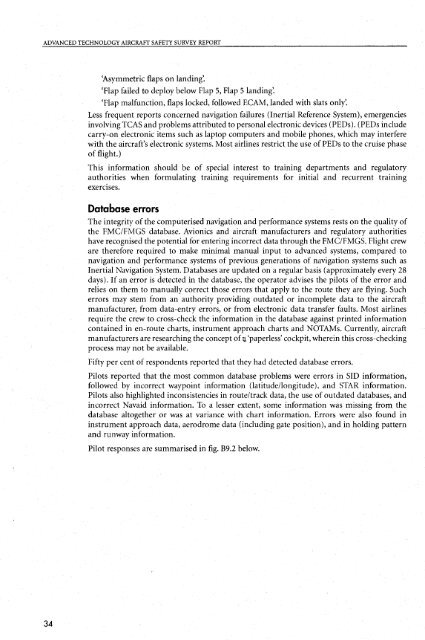Advanced Technology Aircraft Safety Survey Report - Australian ...
Advanced Technology Aircraft Safety Survey Report - Australian ...
Advanced Technology Aircraft Safety Survey Report - Australian ...
Create successful ePaper yourself
Turn your PDF publications into a flip-book with our unique Google optimized e-Paper software.
ADVANCED TECHNOLOGY AIRCRAFT SAFETY SURVEY REPORT<br />
34<br />
‘Asymmetric flaps on landing’.<br />
‘Flap failed to deploy below Flap 5, Flap 5 landing’.<br />
‘Flap malfunction, flaps locked, followed ECAM, landed with slats only’.<br />
Less frequent reports concerned navigation failures (Inertial Reference System), emergencies<br />
involving TCAS and problems attributed to personal electronic devices (PEDs). (PEDs include<br />
carry-on electronic items such as laptop computers and mobile phones, which may interfere<br />
with the aircraft’s electronic systems. Most airlines restrict the use of PEDS to the cruise phase<br />
of flight.)<br />
This information should be of special interest to training departments and regulatory<br />
authorities when formulating training requirements for initial and recurrent training<br />
exercises.<br />
Database errors<br />
The integrity of the computerised navigation and performance systems rests on the quality of<br />
the FMC/FMGS database. Avionics and aircraft manufacturers and regulatory authorities<br />
have recognised the potential for entering incorrect data through the FMC/FMGS. Flight crew<br />
are therefore required to make minimal manual input to advanced systems, compared to<br />
navigation and performance systems of previous generations of navigation systems such as<br />
Inertial Navigation System. Databases are updated on a regular basis (approximately every 28<br />
days). If an error is detected in the database, the operator advises the pilots of the error and<br />
relies on them to manually correct those errors that apply to the route they are flying. Such<br />
errors may stem from an authority providing outdated or incomplete data to the aircraft<br />
manufacturer, from data-entry errors, or from electronic data transfer faults. Most airlines<br />
require the crew to cross-check the information in the database against printed information<br />
contained in en-route charts, instrument approach charts and NOTAMs. Currently, aircraft<br />
manufacturers are researching the concept of 3 ‘paperless’ cockpit, wherein this cross- checking<br />
process may not be available.<br />
Fifty per cent of respondents reported that they had detected database errors.<br />
Pilots reported that the most common database problems were errors in SID information,<br />
followed by incorrect waypoint information (latitude/longitude), and STAR information.<br />
Pilots also highlighted inconsistencies in routehrack data, the use of outdated databases, and<br />
incorrect Navaid information. To a lesser extent, some information was missing from the<br />
database altogether or was at variance with chart information. Errors were also found in<br />
instrument approach data, aerodrome data (including gate position), and in holding pattern<br />
and runway information.<br />
Pilot responses are summarised in fig. B9.2 below.
















